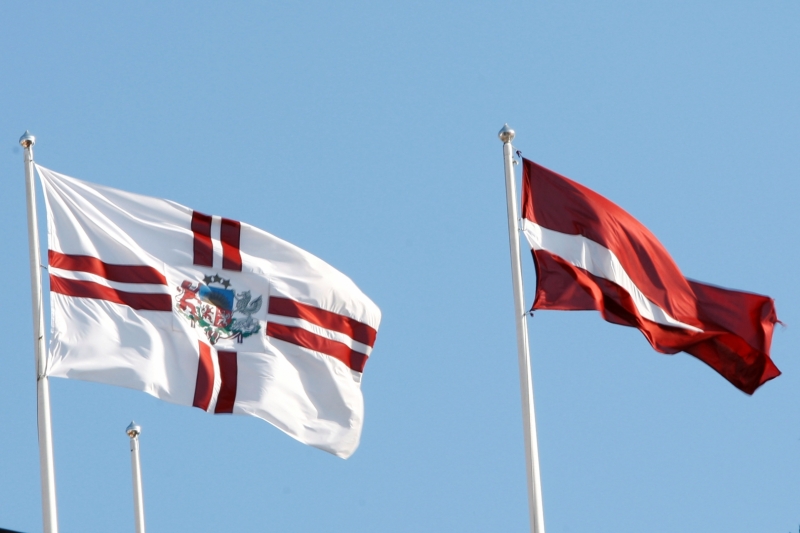Visitors attending events with participation of the president of Latvia must follow approved dress code. Event or theme-specific dress code for the event is usually indicated in the invitation. Please note that dress code on the invitation will always refer to gentleman’s wardrobe. International business etiquette requires women to adjust their dress to gentleman’s clothes. Invitation may contain additional instructions or guidelines regarding the clothes of choice.
Dark suit
Dark suit is the most common dress code for business. You can wear dark suit to official events during the day or at night. A ‘dark suit’ is a monochrome black, navy or dark grey men’s suit, combined with white or another monochrome shirt and a mandatory tie. All jacket buttons, except for the bottom one, have to be done if there are at least two buttons.
Costume suit, women’s suit or a dress is the equivalent of male dark suit for women. This formal wear must be monochrome (no patterns or flowers), but women are allowed to wear brighter colours than men. The preferred skirt or dress length is knee or below knee.
Dress etiquette encourages women to wear more subdued attire at events attended by the first lady to avoid overshadowing.
Semi-formal
This dress code applies to events that are commonly less formal but still require a more sophisticated attire rather than casual. Such events would include meetings between the president and school children or youth, Christmas events for families and other similar occasions. Since dark suit requirements cannot be applied to children or youth, semi-formal dress code would imply clothing that is above casual and matches the occasion and significance of the event. Accompanying adults should follow the dark suit guidelines.
Black tie
Tuxedo is an elegant evening attire for a reception, ball, opera or theatre play opening night after 6 p.m.
Men’s tuxedo jacket is similar to that of a classic fit suit, usually black, with peak lapels or shawl collar, collar will always be silk, trousers (black) without turn up, silk stripe sewn over the outside seam of the leg, white shirt, classic or upright wing collar shirt, black bowtie, black silk cummerbund worn with pleats (pockets) facing up, accompanied by sophisticated, laced black leather shoes or black patent leather tuxedo dress shoes and silk socks, white breast pocket square is optional. All tuxedo jacket buttons, except for the bottom one, have to be done if there are at least two buttons.
When invitation requires men to wear a tuxedo women can choose between short and long gown, unless it is expressly specified otherwise. A ball with dances requires long gown, while a short gown is suitable for receptions. A more sophisticated women’s suit or elegant knee or below knee-length skirt suit is also appropriate. Dress or skirt may have slit. Dress can have subtle decolletage, while shoulders must be covered. Evening attire must be monochrome. There are no other colour restrictions. Ladies should wear high heal court shoes with this evening attire. A small, elegant clutch will be the best accessory.
NB! Be extra careful when choosing the attire for the events attended by the first lady.
White tie
White tie is an evening dress for very special occasions. There are very few remaining white tie events these days. However, if you get invited to one, getting the white tie right might take serious preparation to match the profile of the event.
You may be invited by a president to a white tie event if it is a special dinner in honour of a foreign dignitary (for example, a state dinner) or a significant national holiday, such as proclamation of the republic on 18 November.
White tie requires a black jacket (coat tail) with extended tails and a slit on the back. Front ends at waist. Jacket must have silk lapels. Trousers must be black, no turn-ups. Black side strips. White waistcoat with three buttons, all done. White pique shirt with upright wing collars or shirt with hidden buttons or sophisticated buttons. White bowtie, elegant cufflinks. Matching black patent leather dress shoes and black silk socks. White breast pocket square is optional (not compatible with state awards). Gentlemen may also wear delicate white leather gloves inside. Coat tail is not compatible with wristwatch (gentlemen may wear pocket watch with their waistcoat or keep it in other pockets).
Ladies should wear a monochrome long gown (floor length mandatory). One or both shoulders and back may be partially open. The rear part of the skirt may be extended (with train). Shoes need to be sophisticated, made from delicate leather, with high heels. Delicate stockings. Elegant small clutch made of leather or other fabric, may be embroidered. Women can wear gloves, but it is not a must-have. You can hold a glass when wearing gloves, but they must subtly come off once seated at the dinner table. Jewellery must match the gown (bijou jewellery not allowed). Wristwatch or hat is not used.
A complete and authentic national costume is a perfect substitute for a white tie attire both for men and women.




